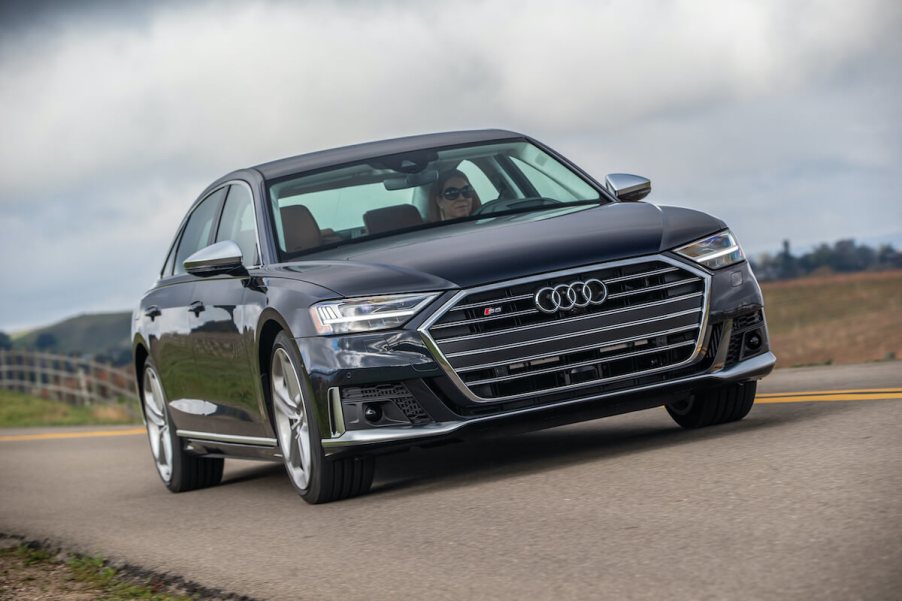
2020 Audi S8: Is it Worth the Extra Money and Horsepower Over the A8?
Faster, sportier and better handling is typically the name of the game when it comes to differentiating Audi’s more civilized “A” model sedans from their enhanced “S” counterparts. That is the case for the all-new Audi S8, which has a new twin-turbo V8 engine and sportier underpinnings as compared to its A8 stablemate, but is more power and better handling worth the money?

The 2020 Audi S8 is similar to the A8 but a little different
The Audi A8 was revised and revamped for the 2019 model year, boasting a completely new look inside and out, a host of new technologies, and a standard long-wheelbase platform. The S8 follows suit, using the same body, but includes dynamic all-wheel steering, a Quattro sport differential, and predictive active suspension as standard equipment to help stiffen things up on the windiest of roads.
The dynamic steering and active suspension are available for A8, but for 2020, they must be added via the “Sport Plus Package,” which also adds sportier 20-inch wheels and tires as well as Audi’s “Black Optics” blacked-out treatment, but it also tacks on $7,800 to the A8’s lofty price tag. Both cars have the same tech features, including the Virtual Cockpit digital instrument panel, dual-touchscreen multimedia interface, and Bang and Olufsen 3D Premium Sound System; it’s actually hard to tell the difference between the two when sitting inside each of them.

What’s special about the S8?
Let’s start with the heart of the matter: the twin-turbo V8 engine. The 2020 Audi S8 houses a 4.0-liter mill that packs a 563-horsepower punch at 6000 rpm along with 590 lb-ft of torque at just 2,000 rpm. By comparison, the 2020 A8 is available with a 4.0-liter V8 as well, but this detuned variant pushes out 453 horsepower and 487 lb-ft of torque, which is over 100 horsepower and 100 lb-ft of torque less.
Not to mention, the V8 engine is an upgrade over the entry-level turbocharged 3.0-liter V6, which produces 335 horsepower and 369 lb-ft of torque. All the added power that the S8 produces translates into a 0-60 mph time of 3.8 seconds and a top speed of 155 mph, while the similarly-clad A8 can get to 60 mph in 4.5 seconds. The V8 version of the A8 is nothing to sneeze at as its performance figures are impressive, considering the size and luxurious nature of the car. However, Audi has proven that the race-inspired S8 will just about blow the doors off of it.

It’s Not Just About the Engine
Sure, the difference in engine performance is the main draw in the S8; after all, a 100-horsepower is a handy bump for such a heavy platform. But the engine isn’t the only highlight, as the S8 comes with a standard torque-vectoring rear differential to help put the power down through standard 20-inch wheels.
Different drive modes (labeled “Comfort,” “Dynamic,” and “Individual”) can further tailor the driving experience to suit the driver’s desires, as each setting will change the steering, suspension, and throttle response to get the most out of the S8. And while this feature is present in the A8, the overall driving dynamics of the S8 prove to be sharper.
The Audi S8 does look sharper as well, thanks to lower side skirts, a more aggressive front grille, and a rear decklid spoiler.
How Does it All Stack Up?
Driving excitement and other features aside, pricing is what sums everything up. The 2020 Audi A8 has a starting price of $85,200 (before destination) and $96,800 for the V8 trim level. While the S8 comes in at $129,500 (before destination), which is an over-$32,000 difference between the S8 and the top-trim A8 model.
So is the S8 worth it? Considering the option package list is nearly identical between both models, and the main difference is the extra 100-plus horsepower coming out of the S8, we would have to say that it’s not. The price difference between the two cars is just too great; in fact, for the price of the S8, you could buy a 4.0-liter Audi A8 model and still have enough money left to buy a brand-new Honda Accord. That route might prove to be a better value in the long run.





